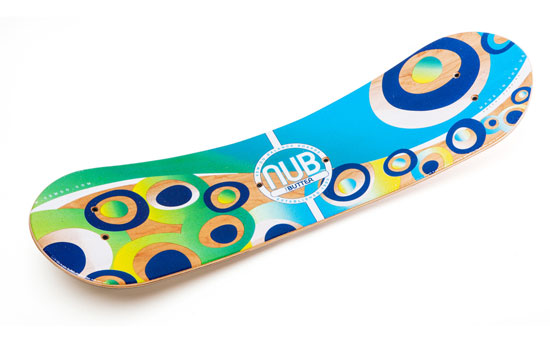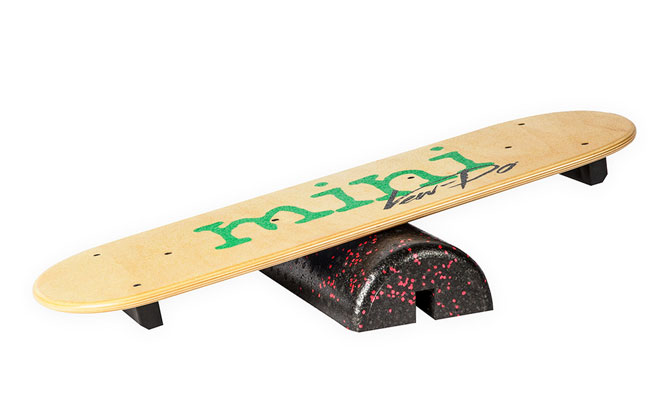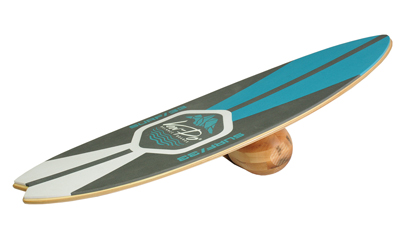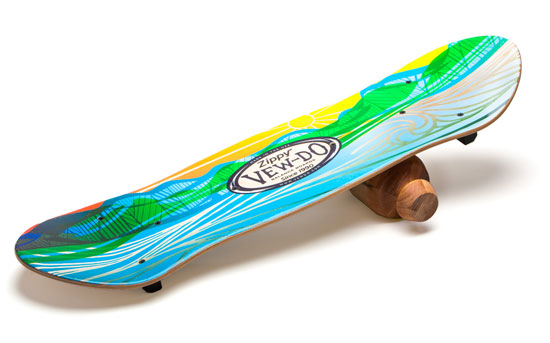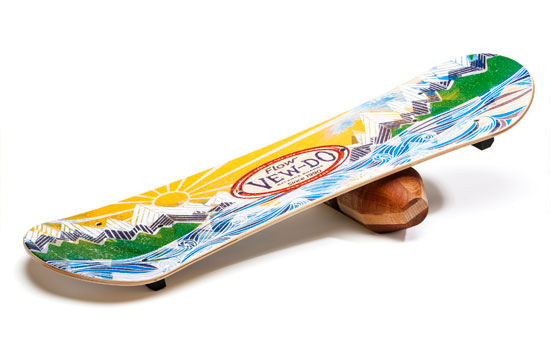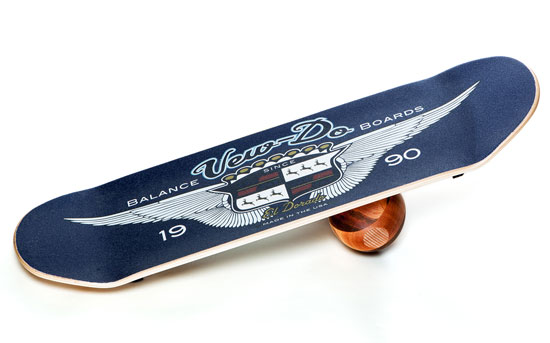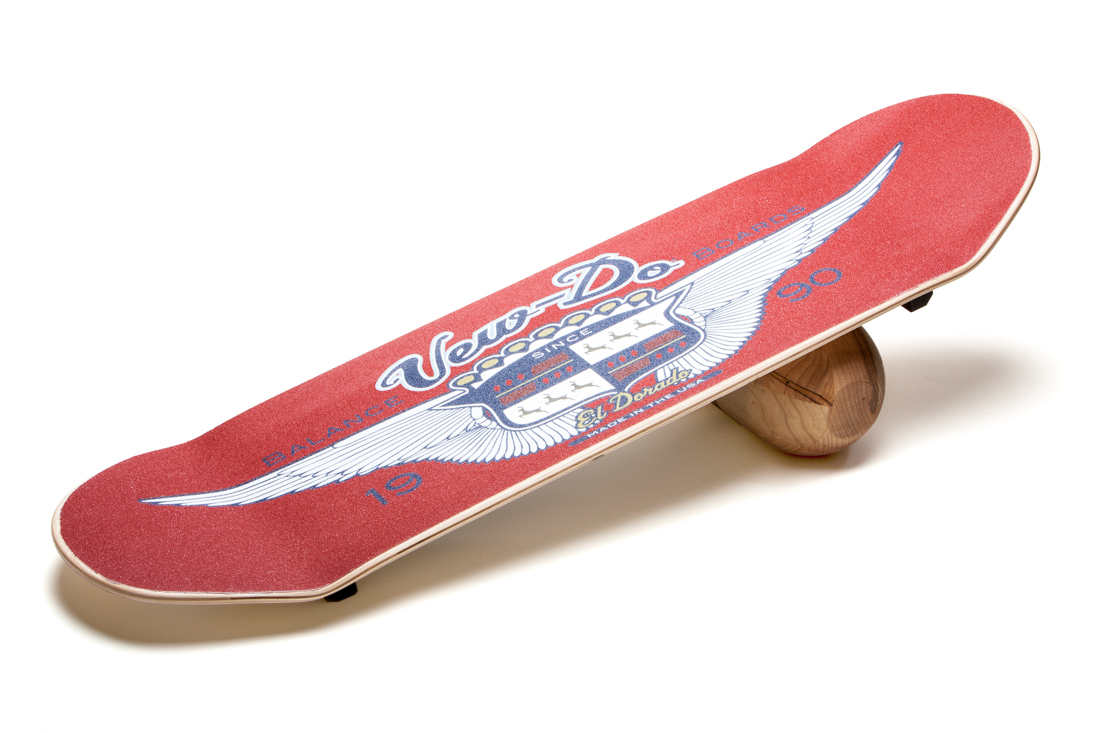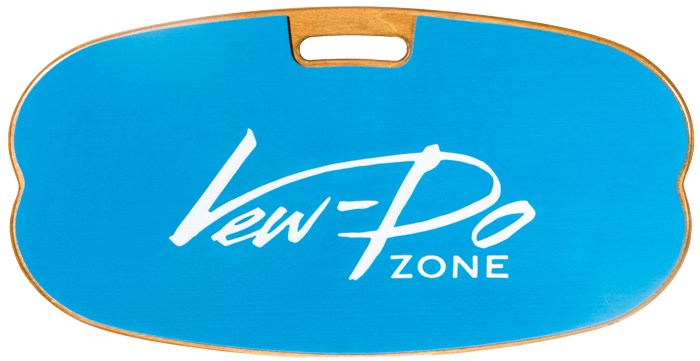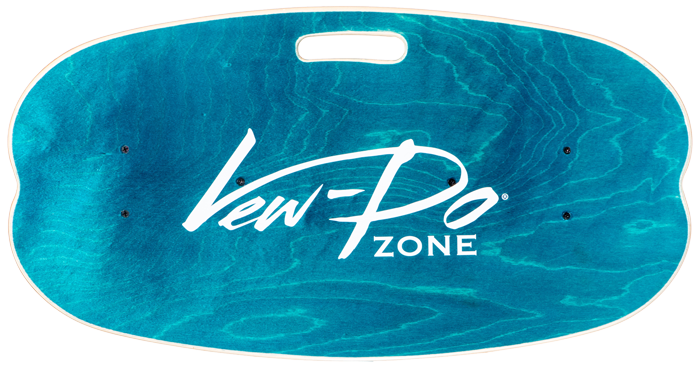Balance Board Strength & Endurance Training for Wrestling
Second only to losing, the worst feeling in the world for a wrestler is 'dying on the mat." The term isn't literal; it refers to the helpless feeling of hitting the wall in competition. It means you're so tired and fatigued during a match that you're muscles fail and you can barely move, let alone continue wrestling.
And right behind failed endurance is the frustration of lacking the core strength required to move your opponent around on the mat. Often ignored, the strength to move your opponent is unattainable without balance.
Ever heard of the term "firing a cannon from a canoe"? It refers to the inefficiency of powerful forces being applied while on an unstable or unbalanced base.
I've been around and used Vew-Do Balance Board training for years. From gold medal skiers and snowboarders to football players and wrestlers, however, Vew-Do's Flow Balance Board is the ultimate supplement to your wrestling balance, strength and endurance training equipment bag of tricks. I'll tell you why and how in a minute, for now though, let's talk about the kind of wrestling skills you "don't" want.
Your perfect wrestling opponent has the following physical characteristics and traits on the mat. And they "are not" traits you want to have. You don't want to be one of these wrestlers. Bad wrestling exposes wrestlers that are:
- Unbalanced
- Unconditioned
- Unskilled
Of the three, being unbalanced strikes at the core of becoming an elite wrestler. Oddly enough, it's often ignored even though it's proven to be trainable. Skill and strength are born from good balance and perfecting the skill of balance recovery. Every move from neutral to the referee position needs balance for proper execution.
Since you will be destabilized during a match by your opponent, your ability to recover your balance once you have become unstable is just as important as being balanced when executing a move.
Now back to the Flow balance board. The Flow uses a wide, flat Maple deck that can be combined with a standard rock or with Vew-Do's Plyometric Rock System.
This gives users versatility and the ability to start training immediately instead of the learning curve required for one of Vew-Do's dynamic balance boards. This even allows wrestlers to train on it in the bottom referees position.
This board is perfect for loaded strength training exercises and allows the use of resistance bands, which is great for rehab as well as strength and endurance training. Its sturdy, lightweight and completely portable.
Here's how you can use the board for wrestling training
Plyometrics - Increase upper and lower body power using lateral and vertical jump training drills or plyometric push-ups. A Vew-Do Balance Board is a great tool for plyometric training exercises.
Balance Training - Use a Vew-Do Flow Board for balance training and perfecting balance recovery. Along with improved balance, you'll also recruit balance recovery muscles and strengthen ligaments and tendons surrounding high stress areas like knees and ankles.
Strength Training - Perform loaded and unloaded strength training exercises on your Vew-Do Balance Board. The unstable base forces recruitment of critical small and large muscle groups around the ankles, knees and torso. Remember, strength training isn't just to increase power, stronger muscles protect joints, ligaments and tendons from injury.
Endurance Training - Perform loaded and unloaded fitness and cardio exercises like squats, push-ups, lunges, planks and plyometrics. I like to set up circuit training workouts incorporating both strength and endurance exercises.
Perturbation Training - Perturbation training hones the ability to defend and recover balance stability caused by outside forces. For wrestlers of course, that means your opponent. Here are some generic perturbation training exercises. They are effective for wrestlers as they are for football players.
Along with all other sports, wrestlers are now using Vew-Do Balance Boards in their training.
By: Rick Contrata
Balance Board Lacrosse Coordination & Agility Training
According to a report by US Lacrosse, participation in the sport almost doubled from about 250,000 athletes in 2001 to over 480,000 in 2007.
Ever hear of the term, "you can't train size"? With team sports like football and basketball, size matters. You only need one hand to count the number of 5'6" pro football or basketball players out there.
Lacrosse is different. It's a sport combining the skills of basketball, soccer and hockey, however, you don't have to be big or even strong to play. Male or female, coordination and agility are the two most important skills needed to be a successful LAX player. Add quickness and balance and you'll have the tools to excel in the sport.
Speed is somewhat of a genetic gift. Although small gains can be made in speed from training, it's mostly dependent on the volume of each athlete's fast twitch muscle fiber composition; purely genetic. Balance on the other hand is trainable. The gains must be continuously worked on to be maintained, but lacrosse, like other coordination dependent skill sports like baseball and golf require the same repetitive training to stay sharp.
Vew-Do Balance Boards are the perfect training tool for lacrosse players at every experience level. Practicing repetitive lacrosse training drills on a Vew-Do Balance Board forces the athlete to execute movement from a balanced state and adapt to balance recovery methods to bring the athlete back to center after loss of balance.
Below, you will find a short list of lacrosse skills you can perfect using a Vew-Do Balance board followed by a set of sport specific lacrosse balance training, balance recovery and basic skill sharpening drills.
- Throwing
- Catching
- Shooting
- Cradling
- Passing
- Checking
Make it a habit to try and drill with your equipment on. This goes for most sports, but even more so for lacrosse and football. Here's the description of some training drills you can practice using the Vew-Do Board:
Wall Ball - Balance yourself on the Vew-Do Board, cradle, then toss the ball into a concrete, cinderblock or brick wall and catch it on the rebound. Mark a specific part of the wall with an X or a box and aim for the target. Switch hand and foot positions and repeat. Here's a money saving tip ... avoid areas with glass windows and doors.
Active Catching & Throwing - Using a partner, practice catching and throwing while you're balancing on the Vew-Do. Even if you only have access to one Vew-Do Board, alternate between the person on the board and the person off the board. Having a board for each player is best.
Perturbation Training - This is an offensive and defensive checking exercise. Center yourself on the Vew-Do Board and have a teammate try to disrupt your balance by lightly pushing, shoving or faking contact. Practice recovering balance due to contact from upper, mid-section and lower body contact. For more perturbation training exercises, click here.
The Zippy is the best Vew-Do Balance Board model for LAX players. With its concave Maple riding deck and easy entry outrigger rock, the Zippy designed for controlled heel/toe and intermediate level balance training. The Zippy is also a multi-sport, multi-use balance board. It offers the user the versatility of plyometric, strength and endurance training.
Go lacrosse, go Vew-Do and go Zippy. Click on the link below for more info.
By: Rick Contrata
Balance Board Strength Training & Injury Prevention for Basketball
Can you dunk? That's probably the number one question every basketball player has been asked.
In basketball, nothing gets players, fans and the media more stoked than the slam-dunk. Michael Jordan is famous for his graceful, acrobatic dunks; almost looked like he was suspended in mid-air. And everybody knows that Shaquille O'Neal shattered a few glass backboards with his power-dunking.
Whether it's the dunk, the jump shot, rebounding, offensive or defensive play, just about every skill-set in basketball requires core-balance, power and agility.
"Striking a balance between stability and strength is the basis of basketball training as well as most other sports." - Erik Phillips, M.S., A.T.C. Phoenix Suns head strength and conditioning coast.
Even after you successfully initiate a play; safely executing that dunk, jump-shot or rebound isn't complete until you've landed without injury? And to do that, you need this:
- Core balance stability and balance recovery
- Strength under load
- Plyometric power (jump training)
- Proprioception/Spacial awareness
- Joint, tendon and ligament stability
- Ability to deflect and defend your defensive and offensive positions
Which brings us to the question, how do you train? For basketball players, it's on a Vew-Do Zippy Balance Board. The Zippy is the perfect intermediate multiple sport balance trainer for cagers. This versatile balance board trains you for:
- Core Balance - 360 degrees of dynamic balance and graduated heel/toe balance recovery.
- Strength - When used for loaded and unloaded exercises with weights, resistance bands or body weight.
- Plyometrics - For power and quickness, the Zippy is a plyometric ready balance board.
- Proprioception - For in-air core stability and centering body rotations.
- Endurance - Full cardio and fitness balance board training routines.
- Injury Prevention - Joint specific strengthening and stability under stress.
- Balance recovery and stability from external forces.
Heck, don't just take our word for it. In a recent article in Men's Health Magazine on alternative training methods, 2 time MVP Steve Nash of the Phoenix Suns is pictured doing his strength training workout on a Vew-Do Balance Board. And its one reason why the Suns consistently rank as one of the least injured teams in the NBA.
Correct take-off, proprioception and landing technique are key to shot and rebound execution. Basketball play also requires bursts of speed and constant adjustment of foot patterns for both offensive and defensive play.
All this activity begs for core balance stability at the start of execution. Moves begun with poor balance stability lead to bad take-offs, bad in-air body alignment and poor, off-balance landings. Offensive and defensive maneuvers like lateral shuffling and dribbling require the ability to maintain a balanced stance at all times.
IIn addition to the above, two barriers for success and longevity in this sport are injury prevention and joint stability. Both of these are often ignored in all sports even though you can train for both of them. Strengthen the large and small muscle groups around your joints and you're building a personal insurance policy against injuring tendons and ligaments from over-stress during play.
That brings us right back to a great training tool addition to your routine - The Vew-Do Zippy Balance Board. Get the balance board that gets it done.
By: Rick Contrata
Balance Board Baseball & Softball Power & Eye-Hand Coordination Training
Going, going …gone. Even though baseball is a game of singles, every player secretly wants to blast a home run into the center field seats every time they step up to the plate. Hitting for power has always been baseball's premier play. Even more exciting than base stealing, double plays and the suicide squeeze.
Everybody knows it takes strength, power and eye-hand coordination skills to excel in baseball and softball.
Second only to golf, accurate eye-hand coordination makes or breaks the skill level of baseball players. Whether it's hitting, fielding or base running, the ability to coordinate eye-hand movement and eye-foot movement with power separates the good from the best at every level of the sport.
The problem is you also need to have good balance combined with a minimum core strength and power baseline for balance stability. Like anything else that's built solid. You have to build it from the ground up. It has to start off balanced and each additional layer has to be strong enough to support the structure above it. The same is true for baseball players as well as athletes in every sport. Without core balance stability, true power and eye-hand coordination is likely to be flawed.
Vew-Do Balance Boards make a couple of balance training tools that fit the balance, power and eye-hand coordination needs of baseball players. The Flow is a dynamic balance trainer that also gives its rider the ability to hone intermediate heel/toe balance recovery skills. The Zippy is also plyometric ready. When paired with the Vew-Do Plyometric Rock Training System™, the Zippy morphs into a plyometric power training tool.
Below are some basic balance, power and eye-hand coordination drills for baseball players.
Eye Hand Coordination Drills:
Soft-toss hitting - The same drill you've been doing for years, except now you'll add balance stability to it. Using a bucket of wiffle balls and a fence as a backstop, balance on your Vew-Do and have a teammate or coach soft-toss pitch them as you practice hitting.
Ball-to-glove drills - Balance on your Vew-Do Balance Board while you catch and throw to a teammate. Or practice throwing and catching solo by bouncing a tennis or rubber ball off a solid wall.
Balance Training Drills:
Lateral & heel/toe balance recovery - Mount the board comfortably with your feet placed slightly outside shoulder width. With your knees slightly bent, Put the board in motion laterally by alternately weighting and un-weighting from one side to the other. Practice heel/toe balance recovery by pivoting your ankles from heel to toe. Remember to keep your hips centered in relation to your body and the riding deck of the board.
Hip rotation - Use the same stance as the lateral exercise. Keep your lower body stationary as you rotate your upper body at the hips. Using a teammate or coach, add a live catch and throw step to each rotation for additional eye-hand coordination drilling.
Balance Board Strength & Power Drills:
Perform lunges, squats, push-ups etc, using weights, resistance bands or your own body weight. Increase the intensity by increasing the speed and frequency of the exercises.
Plyometrics - Increase upper and lower body power using lateral and vertical jump training drills or plyometric push-ups.
Adding these balance board drills and exercises to your training protocol will not only help improve power, balance and coordination, but will also stimulate and recruit additional stabilizer muscles not normally trained during conventional workouts.
By: Rick Contrata
How do NFL Cheerleaders Train - NFL Cheerleader Training
"Almost every exercise we do using our The Vew-Do Boards gives us an ab workout"- Kristen O'Neil - New England Patriot Cheerleader
In 2006 I interviewed Kristen O'Neil, (At the time a veteran NFL cheerleader for the New England Patriots). She exposed her NFL cheerleading training and workout methods. The conversation became known as " The Workout Confessions of an NFL Cheerleader."
Read on and what you will find out is information on how Kristen and the rest of the New England Patriot Cheerleaders work out and use their Vew-Do Zone Balance Boards for their balance, fitness and agility training. Let's get on with the confession.
Workout Confessions Of An NFL Cheerleader
Everybody knows that NFL cheerleaders must maintain a healthy, fit and glamorous appearance, but what you might not know is the amount of physical training that's involved to keep themselves sculptured, yet glamorous and performance ready.
Kristen clued me in to the fact that although they train hard but they don't want to build a lot of bulk and muscle tissue. We're talking bodies like a ballet dancers not a weight lifters.
Their training method includes conventional conditioning and training routines like running and cardio workouts, aerobics and even kickboxing ... along with the use of elliptical machines and light weight training.
A balanced nutritional program is also a very important because starving yourself doesn't work and is not healthy. Like any athletic performer, cheerleaders need to replenish their energy stores through proper dieting and hydration. Cheerleaders are susceptible to cramping, muscle pulls and tears just like any other athletic performer.
The shape of low impact fitness training for these curvaceous professionals means the Vew-Do Balance Board has become a non-conventional but integral part of their workouts. Check out what some of training methods are...
Vew-Do Board Push-Ups - This all-around favorite of Kristen and the rest of the squad can be done with a single board or an additional board. With the single board set up on a "roller" rock, the arms are placed shoulder width apart at each end of the top of the board similar to a conventional push-up.
With the legs extended and the toes pointed, a conventional push-up is performed with an added twist that really works the abs. During the up and down motion of the arms, the board is teeter-rolled from left to right. When this move is done correctly, the added side to side motion puts an additional torque in the abdomen area.

By adding an additional board to the foot area, the combination of the push-up, the lateral "teeter" rock balancing and the additional board at the feet, transforms this exercise into a total-body, strength, balance and conditioning workout.

Vew-Do AB Isometrics - Another ab favorite Vew-Do exercise of Kristen is an isometric ab toning exercise. This is done by placing the Vew-Do on the teeter rock, positioning her body vertically to the board and gripping each end.
Unlike a pushup, where hand placement is directly under the shoulders, the hands are positioned forward of the shoulders with the arms and legs extended, toes pointed and supporting her body in a stationary position. By holding herself in this isometric position, after a few seconds, you begin to feel that "ab burn" that tells you you're doing it right. This also works the triceps, shoulders and upper back muscles.

Vew-Do Inclined Squats – This exercise works the quads, calves and abs. The secret to this workout is the added benefits of the inclined Vew-Do Board. Using the teeter rock, the board is placed on an incline. First, perform your squat facing down the inclined board like a skier and it works the quads, calves and abs. Facing up the inclined board adds balance training to the workout and transfers the benefit to the hamstrings, the front of the ankle area and again, the abs.

By: Rick Contrata
"Balance, coordination and agility are key to achieving grace. The Vew-Do Balance Board gives us one training device to help us get the results our clients want. The exercises we have developed can be used by anyone looking for low impact to high impact total body workouts."- Radu, world famous fitness guru and personal trainer to the stars.
Perturbation Training for Offensive & Defensive Linemen in Football
For offensive and defensive linemen in football, perturbation training is a necessary drill for counterbalancing the constant threats of becoming off balance because of your opponent during line play. Here are a few Vew-do Balance Board perturbation drills for offensive and defensive linemen.
For each drill, stand on your Vew-Do Balance Board placing each foot at the ends of the board using the same foot placement width you would use on the field.
With your knees slightly bent, your head up, back straight and hips in, start off slow and have a teammate push off each of your shoulders to try and disrupt your balance. Each time you feel off-balance; use your ankles, hips, arms and head to recover your balance. Balance recovery is achieved when your core is centered again on top of the board.
Remember to change levels during the drill to simulate coming out of your down stance and initiating blocking and pass rushing techniques. Have your opponent increase the speed and force of perturbation as your balance improves.
Read this article for more information on ankle, hip and step balance recovery strategies
In the next drill, switch to hand fighting with your partner and simulate disrupting your balance by pushing off your opponent with force. Use ankle, hip and upper body balance recovery strategies to re-establish your balance again. Remember to change levels during the drill. Increase the speed and force as balance improves.
The next drill can be done alone, but you will need at least one, and preferably two, 4 ft. lengths of thin aluminum bars or rods. A 48" drywall t-square works well. They cost about 15 bucks a piece and can be bought at your local Home Depot, Loews or hardware store. If you're wondering why, try this:
Grab the lengths of aluminum about half way down in each hand. Hold them up in front of you at chest height and shake them back and forth. The aluminum moves back and forth and vibrates.
Now try it standing on the board. As in the other drills, change levels and increase the intensity of the vibration by shaking the rods faster. Try it with the rods out to the sides, above your head and at your waist.
To increase the difficulty of the drill, stand on one leg. Want more? Stand on one leg and tip your head back. Try it with closed eyes on one leg with your head back for the ultimate solo perturbation challenge.
Since every player on the field comes in contact with the opposing teams players, these same exercises are applicable to every position. Perturbation training drills like the ones listed here will also help athletes in other sports like:
- Hockey
- Basketball
- Wrestling
- Mixed Martial Arts
- Boxing
- Soccer
- Lacrosse
By: Rick Contrata
Discover Football Balance Board Core Strength and Balance Training
All football players want the same thing. It starts with pee wee football on the local Pop Warner fields and progresses through high school and maybe even college, however, every player dreams about getting a shot at playing in the NFL.
Every one of the desired positional skill-sets listed below is trainable, but they all require exceptional balance and strength in addition to athletic ability.
- Quarterbacks want to throw long spirals for touchdowns and avoid sacks.
- Offensive linemen want to open wide holes and pancake their opponent on every play.
- Running backs want to score by running over and away from linebackers and defensive backs.
- Defensive backs want to stick to receivers like glue and pick-off passes.
- Defensive linemen and linebackers want sacks and bone-crushing tackles.
- Receivers want to out-run the secondary and catch any pass they can touch.
- And every skill position player is obsessed with their 40 yard dash time.
Superior football players have great balance. That's why their movements are graceful and effortless. They also have the strength to move their opponents around, tackle them or avoid being tackled.
Because Vew-Do Balance Boards have the versatility to train athletes for improved balance recovery as well as the core strength and power necessary to play the game, the NFL teams listed below have added Vew-Do Balance Board training into their performance and conditioning programs over the past 12 years.
- Pittsburg Steelers
- Dallas Cowboys
- Miami Dolphins
- Philadelphia Eagles
- Oakland Raiders
- Chicago Bears
- Tennessee Titans
Without balance, core strength and stability of the lower back and abdomen, fundamental football skills like blocking and tackling, passing and catching are difficult to improve. If your basic skills are weak, you have little chance of progressing to the next level. Here's a short list of Vew-Do Board balance and strength training exercises:
For Balance:
- Lateral balance training
- Vertical balance training
- Heel/Toe balance training
- Static balance training
- Perturbation training
For Strength:
- Dips
- Squats
- Lunges
- Cleans
- Snatches
- Push-ups
- Plyometrics
- Isometrics
Both balance and strength training can be under load using weights, resistance bands and even your own body weight.
The versatility of Vew-Do's balance boards also help athletes like football players increase performance when used for training in the following areas.
- Maintaining core balance & stability over center
- Recruiting large and secondary muscle groups for balance recovery
- Increasing muscular strength and endurance
- Elevating speed, agility, quickness and power
- Improving micro-motor skills
- Rehabbing, injury prevention and improving joint stability
Today, players, coaches and trainers are continuously developing training protocols to take every athlete to higher levels of performance.
Luckily, you don't have to be a pro athlete to use the same training methods and equipment the pros use. This is where a Vew-Do Balance Board steps in and fills the void. Two a-days, running hills and sprints and blocking sleds aren't a whole lot of fun, however, they are necessary for football training and they work.
Training on a Vew-do board is different than the standard football training protocols because the board is fun and exciting to use, even though it's a training tool. Nothing can replace on-field play like passing, catching, blocking and tackling, but Vew-Do training will help you realize your dreams.
How to Balance Train For Golf
"In 2004 I want to work on driving the golf ball in play more consistently. This is achieved with better balance. To have better balance, it was important that I become physically stronger in my lower body through an extensive off-season workout program. This increases my club head speed while allowing me to maintain lower body stability." - Phil Mickelson
Are you satisfied with your current level of play or are you continuously looking to improve your game?
I can tell you from experience that inconsistency fuels frustration from one round to the next. You always want more consistency, So what's one of the enablers for more consistent play? "Balance"... Now hearing this from me isn't going to impress you. But...
Hearing it from Manuel de la Torre a World Golf Teachers Hall of Fame Member and twice named by Golf Magazine as one of the top 100 golf instructors in America will get your attention. So, with the help of Mr. de la Torre, I'll show you how and why balance training gives you more consistency and what balance board training equipment you should be using.
On the subject of golf balance training this is what Manuel de la Torre had to say:
"If each swing feels different than the one before and your shots lack consistency, an aggressive weight shift to your right side during the backswing may be disrupting your balance. I teach my students to be in balance. To keep their weight centered between their feet from address until impact."

Another way to think of this is that you should be able to stand and swing on a platform while balancing on a log. See *Figure 1* above. Only after impact will the platform tilt toward the target as the majority of your weight shifts to the left side.
Some teachers are in favor of a big shift to the right side, often known as "loading the right side." But I've found that players who heed this advice have difficulty making consistently solid contact.

Loading the right side changes the bottom of your swing arc, that point where the club contacts the ground. To understand the dangers, assume a top-of-the-swing position by making an aggressive move to you right side. See *Figure 2* above. Then, without moving your legs or body, let your arms lower the club to the ground. It will hit the ground several inches behind the ball. That's because your center has been moved laterally from its address position that far behind the ball.
To make solid contact, you must precisely reverse this lateral motion in the forward swing, a difficult move to execute successfully and consistently unless you have hours to spend on the practice range.

Swing to the top again, but this time, keep your weight evenly distributed between your feet, See *Figure 3* above, and perform the same test. The club will drop into the position it held at address because your center has remained fixed over the ball. This leads to greater consistency, especially if your practice time is limited.
Use the image in *Figure 1* on top to acquire the feeling of centralized balance. As you swing back, concentrate on rotating your torso around the center of your body and avoid any impulse to move your center laterally. You'll quickly see a lot more consistency in your game.
By: Rick Contrata







